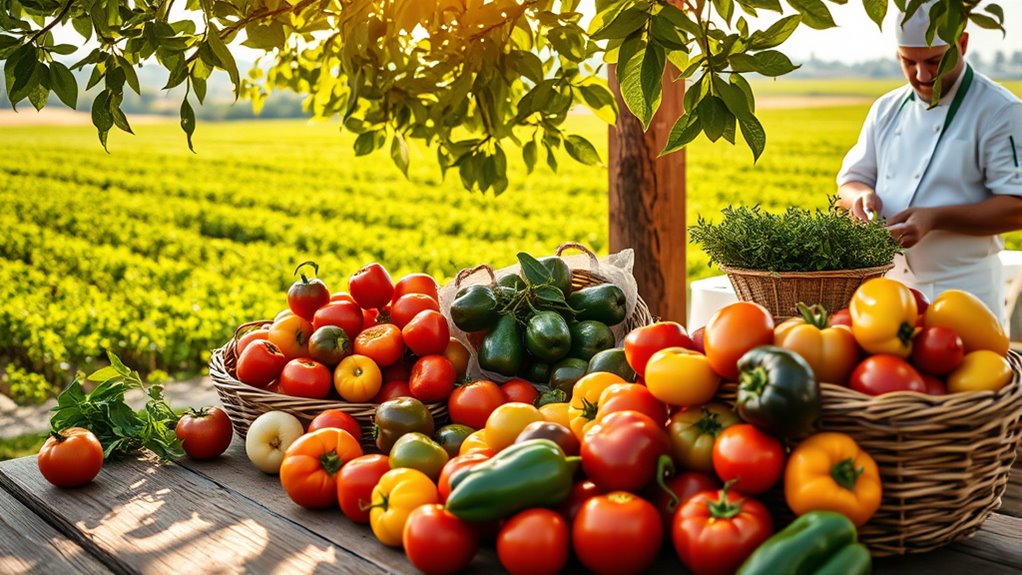Eating within a 50-mile radius, also known as hyper-local sourcing, connects you directly with nearby farmers and producers, supporting your community’s economy and promoting fresh, seasonal foods. It reduces environmental impact by cutting transportation emissions and encourages sustainable farming practices. This approach helps you enjoy flavorful, nutrient-rich produce while fostering a deeper appreciation for local agriculture and ecosystems. If you want to discover more about how this benefits you and your community, there’s much more to explore.
Key Takeaways
- The 50-mile menu emphasizes sourcing ingredients within approximately 50 miles to promote freshness and support local producers.
- It encourages seasonal eating, aligning meals with naturally available local produce to enhance flavor and nutrition.
- Hyper-local sourcing reduces transportation emissions, contributing to environmental sustainability and lowering the food’s carbon footprint.
- This approach fosters community connections by directly linking consumers with nearby farmers and food producers.
- It promotes transparency and trust in food origins, allowing consumers to make mindful, eco-friendly choices.
Benefits of Eating Within a 50-Mile Radius

In recent years, hyper-local sourcing has gained popularity as a way to connect consumers directly with their nearby producers. This approach isn’t just about getting fresh food; it’s about building a community around the food you eat. When you choose to shop from local farms or visit farmers’ markets, you’re reducing your food miles and supporting the local economy. The idea is simple: keep your food within about 50 miles of where you live. This creates a “50-mile menu,” where most ingredients are sourced from your immediate region. It’s a way to guarantee freshness, boost sustainability, and foster a closer relationship with the people who grow your food.
You might find that this approach changes the way you think about your grocery list. Instead of relying heavily on imported items or mass-produced goods, you start seeking out local vegetables, fruits, meats, and dairy. Farmers’ markets become your go-to spots, where you can chat directly with producers, learn about their growing practices, and understand exactly where your food comes from. You might even develop relationships with farmers, who are happy to share tips on how to prepare their products or suggest seasonal ingredients. This transparency gives you confidence that your food is fresh, minimally handled, and environmentally friendly.
Living within a 50-mile radius means you also play a part in reducing your carbon footprint. Longer transportation routes contribute considerably to greenhouse gas emissions, and by sourcing locally, you cut down on those unnecessary miles. Plus, local farms often use more sustainable practices compared to large industrial operations, which rely on heavy machinery, synthetic fertilizers, and pesticides. When you stick to the 50-mile menu, you’re supporting farms that prioritize soil health and eco-friendly methods, helping preserve local ecosystems. Emphasizing local food systems further strengthens community resilience and promotes sustainable agriculture.
Choosing local farms reduces emissions and supports eco-friendly practices that protect our ecosystems.
Additionally, hyper-local sourcing often encourages seasonal eating. You learn to adapt your meals to what’s available at different times of the year, which can make your diet more diverse and exciting. For example, in spring, you might enjoy asparagus and strawberries, while in fall, pumpkins and apples take center stage. This seasonal cycle not only enhances the flavor and nutritional value of your food but also aligns with natural growing patterns, reducing waste and energy consumption.
Engaging in hyper-local sourcing also means you become more aware of the agricultural landscape around you. You gain a deeper appreciation for the effort it takes to produce your food and become more mindful of your consumption habits. It’s about more than just eating; it’s about connecting with your environment and community. By embracing the 50-mile menu, you contribute to a resilient local food system, ensuring fresh, sustainable options remain available for generations to come.
Frequently Asked Questions
How Does Hyper-Local Sourcing Impact Food Prices?
You might wonder how sourcing food locally affects prices. When you choose hyper-local sourcing, you’re supporting nearby farms, which can lead to fresher produce. However, it can also mean higher costs due to smaller scale and limited supply compared to large industrial farms. While prices might increase slightly, you benefit from better quality, sustainability, and supporting your community. Overall, the impact balances out depending on the specific food item and season.
What Challenges Do Farmers Face With 50-Mile Sourcing?
Imagine carrying the weight of an entire farm on your shoulders, just to meet a narrow 50-mile radius. You face unpredictable weather, limited markets, and intense competition from bigger farms. Transportation costs skyrocket, and finding diverse crops is a constant struggle. You’re caught between sustainability and profit, battling nature and logistics, all while trying to keep your farm alive within those tight boundaries. It’s a relentless challenge that tests your resilience daily.
Can Small Farms Sustain Demand for Local Restaurants?
You might wonder if small farms can meet the demand from local restaurants. While they often struggle with scale and consistency, many can adapt by diversifying crops and improving efficiency. Building strong relationships with chefs helps them forecast needs better. Though challenges exist, with innovation and support, small farms can sustain local restaurant demand, fostering a resilient, sustainable food system that benefits everyone involved.
How Does Seasonality Affect Menu Planning Locally?
Seasonality considerably impacts your menu planning because it determines which ingredients are freshest and most flavorful. You’ll need to adapt your offerings as certain fruits, vegetables, and herbs become available or scarce throughout the year. By aligning your menu with seasonal patterns, you guarantee quality, reduce costs, and showcase local produce at its peak. Flexibility in your menu also keeps diners excited and engaged with what’s in season.
Are There Certifications for Hyper-Local Food Sourcing?
Ever wondered if there are certifications for hyper-local food sourcing? Yes, there are some! Certifications like Certified Naturally Grown, Organic, and Local Food Certification help you verify your commitment to local, sustainable practices. These labels build trust with customers and showcase your dedication. While specific hyper-local certifications are rare, adopting recognized standards demonstrates your focus on supporting local farmers and reducing your environmental footprint effectively.
Conclusion
By choosing to dine locally, you gently support your community and enjoy fresher, more flavorful meals. Embracing the 50-mile menu isn’t just about food—it’s about nurturing connections and savoring what’s nearby. Every mindful bite helps foster a sustainable future, making your everyday choices feel a little more meaningful. So, why not explore the delicious possibilities close to home? Your palate—and the planet—will thank you for the subtle, positive change.









